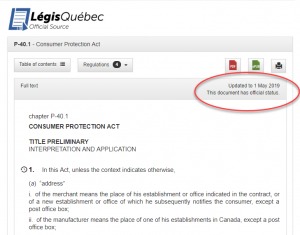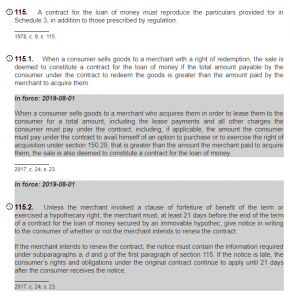Earlier this week, a patron called the library asking about the publication procedure for Quebec legislation. He wanted to know whether the consolidated statutes and regulations published by Publications Québec on LégisQuébec were actually consolidated and up to date, and included any amendments soon to come into force. Specifically, he was seeing some inconsistencies with the Consumer Protection Act.
My initial response was affirmative – after all, the consolidated legislation on LégisQuébec includes an update date and has official status. If a bill amending the legislation had been passed prior to the update date, it would be reasonable to expect that the amendments had been integrated somehow into the official consolidated version.
This expectation was reinforced in me in particular as a result of my experience regularly seeing gray boxes with the amended provisions and coming into force information integrated throughout official consolidated legislation.
Consequently, I believed it was in error that the new section 119.1 of the Consumer Protection Act, introduced via section 27 of Bill 134 and set to come into force on August 1st, 2019 (order in council 987-2018), was excluded from the official, consolidated Consumer Protection Act. To that end, I sent an email to Publications Québec, asking them if this was an unintentional error.
Publication Québec’s Approach to Consolidating Laws
The next morning, I received a phone call from a representative of Publications Québec informing me that there was no error on their part. Rather, the absence of 119.1 from the consolidated act was the result of an editorial decision taken by Publications Québec years ago (and which was too complicated to explain in writing, and better explained verbally).
In sum, I was told that despite the signs that led me to believe that the consolidated legislation published on LégisQuébec does integrate amending legislation not yet in force, in fact, Publications Québec does not integrate all amendments brought in by a new law. This is true even if an order in council has been published in the Gazette officielle du Québec proclaiming the coming into force of the various provisions of the amending law. Confusingly, Publications Québec only integrate SOME amendments.
According to the representative from Publications Québec, an amendment will only appear in a gray box if it modifies a provision currently in force and its coming into force date has been published; anything that is entirely new law will not appear in the consolidated law until it actually comes into force. The justification for this editorial decision? (1) To reduce the number of gray boxes that appear throughout the consolidated legislation and improve the readability of legislation. (2) To minimize the risk of integrating amending provisions that would end up never coming into force.
Implications of Publications Québec’s Editorial Decision
According to the representative from Publications Québec, there is no plan to change their editorial process. What this means concretely, is that:
- When you are looking at a piece of legislation on LégisQuébec, you can never know for sure if tomorrow, that piece of legislation will look entirely different.
- When you are looking at a piece of legislation on LégisQuébec and you see gray boxes with coming-into-force information, you should not assume that it gives you a complete picture of the law soon to come into force.
- In order to obtain a complete picture of a law or to be sure that the piece of legislation you are looking at has not been modified by a law soon to come into force, you will have to:
- Search for a modifying bill;
- Confirm it has received royal assent;
- Search Part 2 of the Gazette Officielle du Québec for coming into force information; and
- Consolidate, either manually or by using a consolidating tool like this one.



This is very interesting. I have been encountering similar issues in Ontario, but have not contacted eLaws to figure out their policy. For example, the new provincial government is potentially going to implement sweeping health care reform in the province–except we don’t really know because the amending bill’s provisions all come into force on different dates, to be proclaimed by the Lieutenant Governor. See, for example, this link to the People’s Health Care Act: https://www.ontario.ca/laws/statute/S19005#BK5
Section 2(3) makes clear that “[i]f a Schedule to this Act provides that any provisions are to come into force on a day to be named by proclamation of the Lieutenant Governor, a proclamation may apply to one or more of those provisions, and proclamations may be issued at different times with respect to any of those provisions.” The Act then enacts hundreds of different amendments to dozens of pieces of legislation, and allows the executive branch to implement the amendments bit by bit as it wants, within whatever time frame it wants. Importantly, some of the changes to the way health care delivery is organized could look very different depending on the order in which the LG chooses to proclaim in force the different provisions. Obviously, the LG might also simply not proclaim in force specific provisions.
Many similar amending statutes have been enacted and the result is that, browsing through the laws of Ontario, you encounter dozens of grey boxes. It is very difficult to keep track of changes in a specific area of the law, given there are dozens of different ways the LG could effectively amend the law by choosing which pre-enacted amendments to proclaim in force, when.
I know that providing for the LG (i.e. executive branch) to choose what day to effectively implement certain legislative changes has its purpose–if, for example, the Legislature wants to give the executive some time to figure out the mechanics of how to implement a specific program of legislative reform. However, on the scale we now see it in Ontario, it looks a lot to me like the Legislature is instead delegating legislative authority to the executive branch, via the artifice of allowing the LG to pick-and-choose which of a suite of hundreds, if not thousands, of amending provisions to proclaim in force, when. If Ontario’s eLaws publishers are operating on the same policy as Quebec’s, that would make it even more difficult to figure out what the law is at any given moment. Or, consequentially, it might make it easier for a government that does not want its legislative agenda to be comprehensively vetted and criticized in the Legislature and the public discourse to obfuscate this agenda by appropriating to the executive branch more legislative power.